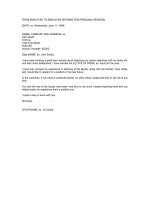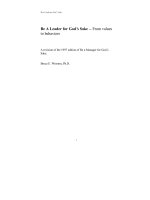Using YouTube: From Consumption to Production
Bạn đang xem bản rút gọn của tài liệu. Xem và tải ngay bản đầy đủ của tài liệu tại đây (3.16 MB, 72 trang )
Using YouTube: From
Consumption to
Production
By Matt Smith,
Edited by Justin Pot
This manual is the intellectual property of
MakeUseOf. It must only be published in its
original form. Using parts or republishing altered
parts of this guide is prohibited without permission
from MakeUseOf.com
Think you’ve got what it takes to write a manual
for MakeUseOf.com? We’re always willing to
hear a pitch! Send your ideas to
; you might earn up to
$400.
Table of Contents
Introduction
The YouTube Interface
Other Ways To Watch
Uploading and Editing
Ads and Analytics
Conclusion
MakeUseOf
Introduction
A Brief History of YouTube
If you’re an Internet-savvy geek it may be difficult
to remember a time when YouTube didn’t exist.
Yet it wasn’t so long ago that the site was little
more than an idea in the minds of its founders
Steven Chen, Chad Hurley and Jawed Karim.
The site opened in 2005, and the first video was
uploaded on April 23rd. Within a year, the site
was receiving over 100 million page views per
day. Even in the world of online business this kind
of growth was astonishing. Easy online video
sharing went from a dream to a basic reality of the
Internet within months.
As a result the site garnered a lot of attention from
other, larger companies. Chief among them was
Google, which paid $1.65 million (in Google
stock) for the company in November of 2006.
Today, YouTube receives over three billion (yes,
with a “b”) page views daily. Video length
restrictions were slowly raised and then lifted, the
interface was redesigned several times, and rentals
of theatrical releases were made available.
Yet all of this change hasn’t altered the basic
reason for YouTube’s existence – sharing video.
For some it is a way of sharing the latest video of
the kids (or cats). For others, it is a way of making
a living.
Content Consumption vs. Content
Production
There are really two sides to the YouTube coin:
consumption and production. YouTube is unique
from most other forms of media because it allows
people using the service to both view content and
create it. Becoming a content creator doesn’t
require any special permission: all you need is an
account and a video file to upload.
Despite this ease, there is still a significant
difference between the parts of the site that content
consumers and content producers need to access.
Many people who use YouTube will do so without
ever taking a serious look at the production
elements of the site, such as the online video editor
On the other hand, a smaller number of people will
spend most of their time on the site staring at the
production interface. These producers will be
uploading and editing videos, managing
advertisements and parsing video traffic data for
important trends
This guide will be dealing with both sides of the
YouTube coin. Since each is separate from the
others you will find that some chapters deal almost
entirely with content consumption while other
chapters deal almost entirely with content
production. Those looking for information about
YouTube’s web interface as well as alternative
ways to access the site should focus on chapters 2
and 3, while those looking for more information on
how to create, manage and promote videos should
refer to chapters 4 and 5.
Of course, some people will be both consumers
and producers, so you’ll likely find this entire
guide useful – even if some parts are more
applicable than others.
The YouTube Interface
Registering Your Account
There’s a good chance that you already have a
YouTube account. But not everyone is a YouTube
fanatic, and those who only browse content may
have viewed the site for years without a login.
Creating an account is painless. When you are not
logged in, you will see a big blue “Create
Account” button at the top of the left sidebar. Press
it, and you’ll be taken to a “Create a new Google
Account” page. That’s right – in order to create a
YouTube account, you need to create a Google
account. What does that mean?
Well, you won’t just have a YouTube account.
You’ll also have a Gmail account. If you already
have a Gmail account you don’t need to register for
YouTube. You can log into YouTube with your
Gmail login and password.
And really, that is about it. At the time of this
writing (early 2012) Google does not require that
new users signing up for a Google Account register
with Google+. You will have the option, and when
you are logged into Gmail and other Google
services without a Google+ account you will see a
tempting “You+” option lurking in various
interface elements.
Get With The Channel
When YouTube was first released, it organized
videos based on the type of content more than
anything else. Since there weren’t many videos,
and the site was intended primarily for sharing,
this worked well enough.
But time changes a site and its audience. As
YouTube became an Internet sensation some
content producers started to use it as a platform for
launching their own creative projects. This
resulted in the dominance of channels. And today,
as of the latest YouTube redesign, channels are the
centerpieces of the site.
“channel” might be confusing. YouTube’s channels
don’t operate anything like a traditional TV
channel. In fact, a “channel” on YouTube is nothing
more than a specific YouTube account. For
example, you might subscribe to Motor Trend’s
channel, and in doing so you are subscribing to
videos uploaded by that account. But you’re not
subscribing to a general selection of car related
videos or even Motor Trend related videos.
You’re simply subscribing to videos uploaded by
Motor Trend.
Content from the channels that you have subscribed
to will appear on the main YouTube page when
you are logged into your account. If you don’t have
any subscriptions, or if you’re not logged in, you’ll
be given a general selection of popular and
sponsored content. This content can be annoyingly
random. That means subscribing to channels is a
requirement if you’d like to start narrowing down
the selection of videos to those relevant to your
interests.
When you subscribe to a channel you don’t just see
their videos on the main YouTube page. You also
see the channel’s name and icon appear in a
subscriptions sidebar on the left side of the page.
If you are subscribed to many channels they won’t
all appear, so you’ll have to click “see all” to open
a full-page expanded interface. You can also
unsubscribe to channels on this page by (counter-
intuitively) clicking on the subscribed button.
Finding New Videos
YouTube’s channel-focused redesign does make it
easy to stay up-to-date with content you love, but it
also buries video categories. This can make
finding new content harder when you just want to
browse the Tube.
There are easy ways to find new videos, however.
The easiest is probably the big “Add Channels”
button that is at the top of the left sidebar. Clicking
on this will present you with channels that you’ve
already visited frequently, or that YouTube thinks
you will like. There is also a “suggested channels”
section that appears low on the left sidebar when
you’re on YouTube’s main page. These suggested
channels are based on the ones you’ve already
subscribed to, so they should be relevant to your
interests.
This still keeps you in a somewhat limited loop of
channels, however. If you really want to look for
something new you’ll need to check out the
sections listed under “From YouTube” on the left
sidebar. Here you’ll find new videos that are
trending or already popular. You’ll also find old-
fashioned categories (just click “see all” under the
“From YouTube” section). YouTube has gone out
of its way to obscure categories from your view,
but they’re still there, and you can still browse
them.
Likes, Dislikes And Comments
YouTube, unlike a lot of other sites with social
networking features, explicitly allows users to like
or dislike a video. These simple votes are
anonymous and persistent. If you like a video,
YouTube will automatically provide you with a
share link.
You can’t change a like or dislike once you’ve
made it: it’s permanent. Re-clicking the like or
dislike button will have no effect – your vote
won’t be counted multiple times, but it won’t be
taken back, either.
Comments are different. You must log in with a
valid YouTube account to leave a comment, so
they’re never anonymous. However, you can
remove a comment that you made. This is done by
placing your cursor over your comment and then
opening the drop-down menu next to the Share
button. Then click on Remove.
You can like or dislike comments left by other
people, as well. Just like video likes/dislikes, they
are anonymous and persistent. You can’t remove
them or change your vote once you’ve made them.
Changing The YouTube Interface
With Browser Extensions
We’ve covered the basics of navigating YouTube
content and comments. Now let’s talk about some
stuff that isn’t so basic.
Officially, the interface for YouTube is basically
set in stone. There’s not much that you can do to it.
Unofficially - primarily through browser
extensions - you can manipulate it quite a bit.
We’ll go through the extensions browser by
browser.
Chrome YouTube Extensions
YouTube Options for Google Chrome - I think it’s
fair to call this the definitive YouTube app for
Chrome. Once installed, you can access a
YouTube Options menu through the extension. This
lets you change default viewing quality and
viewing size, force a secure connection, and
change the layout of the YouTube itself.
Magic Actions for YouTube - While YouTube
Options is more about simple customization,
Magic Actions tries to offer an entirely unique
experience. It dims the content surrounding a video
and enlarges the video itself. You can customize it
to your preferences as well. It’s pretty awesome,
particularly when viewing long videos.
SmartVideo for YouTube - Another custom
YouTube experience, this one has options that
make watching YouTube easier if you have a very
slow connection. I don’t like the look of this
extension as much as the others here but you may
find it worthwhile for the improved buffering
alone.
Firefox YouTube Extensions
Magic Actions for YouTube - The same as the
Chrome extension, more or less, and good for the
same reasons.
Greasemonkey - This is actually a general purpose
extension that allows users to customize pages by
entering their own JavaScript. Fortunately, the
extension’s creators have a database where users
can post their own customizations, so you don’t
have to know JavaScript to use this extension.
There are several popular YouTube customizations
that can change the site, disable certain sections
(including ads) and perform other bits of magic.
Internet Explorer Extensions
Besides YouTube video downloaders, there are no
good IE extensions that are relevant to YouTube.
Opera Extensions
ExtendTube - The Opera version of your typical
YouTube customization extension, except it is
particularly robust. You can change the way the
site looks, alter video quality and content (you can
add lyrics to music videos, for example) and it’s
even possible to customize the YouTube site by
adding your own CSS and JavaScript, if that’s your
thing.
YouWatch - This extension makes browsing
YouTube easier by keeping track of videos you’ve
already watched, enabling advanced search
filtering and making it possible to add videos to
Opera’s Speed Dial. It’s a must-have, even if you
don’t mind YouTube’s default appearance.









